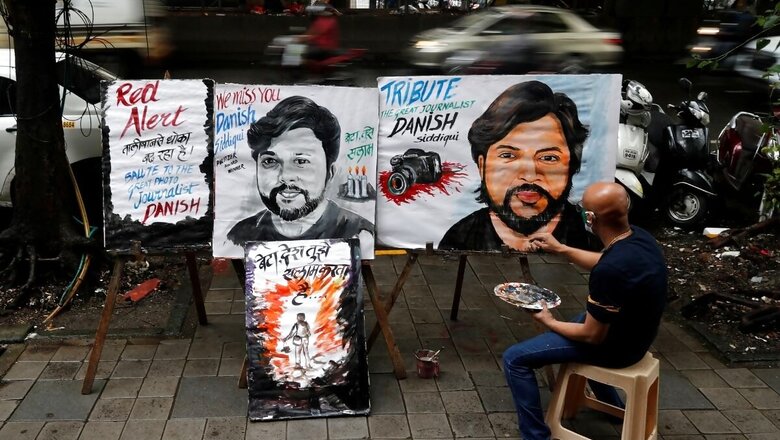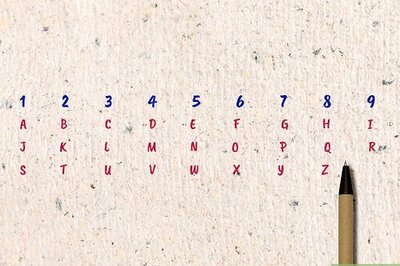
views
The killing of Indian photojournalist Danish Siddiqui in Afghanistan on Friday came as a rude shock for people the world over. Siddiqui, a Pulitzer Prize-winning photojournalist, was chief photographer for the news agency Reuters in India. He was embedded with a convoy of Afghan forces that was ambushed by Taliban militants near a key border post with Pakistan, according to reports.
War-ravaged Afghanistan is not new to the targeted killing of journalists. The country has witnessed killings of 57 scribes since 2016, according to data compiled by UNESCO observatory of killed journalists. The year 2018 was most brutal with 16 journalists killed in the country. In 2016, 13 journalists were killed, followed by 11 in 2017. In 2019 and 2020, five and six journalists respectively got killed. Most of these cases remain unresolved and perpetrators remain at large. In 2021, before Siddiqui, five journalists were killed in the country, four of them female, according to the same UNESCO count.
On June 3, Mina Khairi, a 27-year-old anchor of Ariana News, and her mother were killed in a targeted explosion in capital Kabul. Three women media workers — Mursal Wahidi, Sadia Sadat and Shahnaz Roafi — were shot dead in two separate attacks in eastern Afghanistan’s Jalalabad on March 2, 2021. All the three killed worked for Enikass TV and were known for dubbing popular and often emotion-laden dramas from Turkey and India into “conservative” Afghanistan’s local languages of Dari and Pashtu, according to an Associated Press report.
In January, radio broadcaster and human rights activist Bismillah Adel Aimaq was shot dead by gunmen in the central Afghan province of Ghor.
And not just serving journalists, terror groups have not spared former scribes as well. On May 6, Nemat Rawan — a high-profile former TV host — was shot dead in Kandahar city. Her killing came just a day after the Taliban had threatened the media against “biased reporting”. After quitting television, Rawan joined government ministry, according to reports.
Many of these killings often go unclaimed. While Afghan officials see Taliban’s hand in majority of such targeted killings, the insurgents blame Afghan intelligence service for carrying out these attacks to malign Taliban’s image.
In Siddiqui’s case too, Taliban spokesperson Zabiullah Mujahid denied his group’s role in the killing. “We are not aware during whose firing the journalist was killed. We do not know how he died,” Taliban’s spokesperson Zabiullah Mujahid told CNN-News18.
With the rise of Taliban insurgents in the war-wrecked country, and the insurgent group claiming control of 85% of the country, the risk of such targeted killing of media persons has risen further. From time to time, the Islamic fundamentalist terror outfits have been warning and issuing threats to journalists working in the country.
On May 5, the insurgent group had warned journalists and media outlets over “one sided-propaganda and publication in support of Afghanistan’s intelligence”. In a series of tweets Taliban spokesman Zabihullah Mujahid had warned the media outlets of “consequences” in case they parrot the Kabul government’s stand.
In June 2019, the Sunni Muslim insurgent group had threatened the media against airing government-funded propaganda against them. The government advertisement, according to Radio Free Europe, called on citizens to inform authorities if they see any suspicious Taliban activities.
On January 20, 2016, in one of the deadliest attacks, seven working journalists attached with Tolo TV, Afghanistan’s 24-hour news channel, were killed in a suicide attack in Kabul on a minibus they were traveling in. A day later while claiming the gruesome attack, the Taliban had warned media organisations while accusing Tolo TV of “promoting obscenity, irreligiousness, foreign culture and nudity.”
In December 2014, according to Human Rights Watch (HRW), the Taliban had openly warned of attacks on journalists seen as supporting “Western values.”
It is not just the Taliban that has been at the forefront of targeting journalists. Both state and non-state actors see the media community as a soft target that could be easily intimidated.
Other terror groups, including the dreaded Islamic State (ISIS), too have been on the prowl. The terror group, known for enforcing strict Wahhabi ideology had claimed responsibility for slaying the three women media persons in March this year.
Besides, the Afghan spy agency too has been accused of coercing media to carry the government’s stand through their respective outlets.
These threats of choosing sides, coming from warring quarters, has further imperiled the fragile press freedom and sandwiched journalists in the war-torn country. The sparring forces see media as an all-important and powerful tool for waging psychological warfare against their respective opponents in order demorlise them and spark fear among the populace.
“The Taliban and other insurgent groups have also used the media as a propaganda platform, and actively court the media in their campaign against the government, including pressuring reporters to cover their statements or not to write articles deemed critical,” read an HRW January 2016 release.
After every killing, independent media bodies and world organisations issue condemnation but rarely wrongdoers are brought to justice. This free for all situation due to poor law enforcement has further emboldened the terror groups.
Read all the Latest News, Breaking News and Coronavirus News here.



















Comments
0 comment